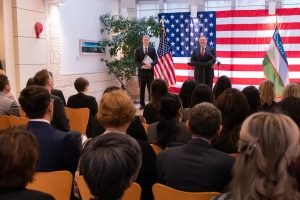By Catherine Putz
 On the heels of U.S. Secretary of State Mike Pompeo’s trip to Kazakhstan and Uzbekistan, the Trump administration officially unveiled its updated Central Asia strategy. At an event hosted by the Heritage Foundation, three officials tasked with building and implementing the strategy discussed its main features.
On the heels of U.S. Secretary of State Mike Pompeo’s trip to Kazakhstan and Uzbekistan, the Trump administration officially unveiled its updated Central Asia strategy. At an event hosted by the Heritage Foundation, three officials tasked with building and implementing the strategy discussed its main features.
The contours of the strategy — officially titled United States Strategy for Central Asia 2019-2025: Advancing Sovereignty and Economic Prosperity — should be familiar to regional observers. The motivation for a revamp wasn’t a shift in American priorities in the region, but the opening of new possibilities prompted by changes in the last few years inside the region itself.
Lisa Curtis, deputy assistant to the president and senior director for South and Central Asia at the National Security Council, commented in her remarks that given “important shifts” that have occured in the region, the administration “decided it was time to update our approach and vision.” Among the changes that “have brought us new challenges as well as opportunities” Curits cited “shifts in leadership dynamics that have given rise to new opportunities for intra-regional cooperation,” renewed threats from extremist ideology, namely the Islamic State and returning foreign fighters, deepening Chinese influence in the region and opportunities for Central Asia to support U.S. peace efforts in Afghanistan.
But, Curtis remarked, many things remain the same in Central Asia and continue to be very important, including “continued, robust Russian influence in all spheres,” serious public health threats such as tuberculosis, trafficking in persons, migration, and the “need to improve human rights and democratic institutions.”
“First and foremost we see the new strategy as re-emphasizing an enduring guiding principal: Strong U.S. support for the independence, sovereignty, and territorial integrity of all the Central Asian nations,” Curtis said.
Ambassador Alice Wells, principal deputy assistant secretary for South and Central Asia, said, “it’s basically the holy trinity of U.S. policy in Central Asia.”
The new strategy’s public version is sorted into six policy objectives: 1) Support and strengthen the sovereignty and independence of the Central Asian States, individually and as a region; 2) Reduce terrorist threats in Central Asia; 3) Expand and maintain support for stability in Afghanistan; 4) Encourage connectivity between Central Asia and Afghanistan; 5) Promote rule of law reform and respect for human rights and 6) Promote United States investment in and development of Central Asia.
Like Curtis, Wells highlighted that the new strategy is rooted in continuity. And that sense of continuity extends to the work of USAID. Gloria Steele, acting assistant administrator for the Asia bureau noted that in implementing the new strategy, USAID would “take lessons learned and build upon programs that we have done in the past and scale them up where appropriate.” Steele reviewed the wide array of areas USAID has interest and experience in developing in Central Asia, highlighting among other areas efforts to “strengthen institutions that characterize true democracy,” recognizing them as foundational for regional stability, development and attracting foreign investment.
If the new policy is rooted in stable U.S. interests both within the region and around it, it also builds off unexpected political windfalls, predominanetly the 2016 death of Islam Karimov, which touched off the current era of opening and refrom in Uzbekistan. Uzbekistan’s embrace, thereafter, of a “good neighbor” strategy and concerted effort to energize regional cooperation has opened new doors.
In her prepared remarks, Wells stated that “We absolutely see that we are in an era of new possibilities.”
What changes signaled this new era? In an interview with The Diplomat just after the launch of the new strategy, Wells said that “The big change is that Afghanistan is a Central Asian state and we need to make our policies reflect that fact and to help the region achieve that level of inter-connectivity which they need as landlocked nations.”
Previous administrations often made Afghanistan policy separate from Central Asia policy, in part because of a “practical reality that President Karimov,” Wells said, “was not prepared to, in any way, on his border at least, engage with Afghanistan.”
A second big change Wells noted is that “you can play now in Central Asia.” Thanks to Uzbekistan, greater regional cooperation is undeniably possible and the fruits of those efforts are emerging: more than a dozen open border crossings between Uzbekistan and Tajikistan, plans for Uzbekistan to invest in building hydroelectric stations in Tajikistan (rather than threats of war over water), renewed talk of a regional electricity market and more. The change in the regional dynamics, Wells noted, now allows for “coherence” between what had previous been separated bilateral initiatives.
Wells, who was with Pomepo in Central Asia recently, said that overwhelmingly there is enthusiasm in the region for U.S. engagement. “They want our diplomatic engagement, they very much value — this is the mantra — sovereignty, independence and territorial integrity because some of their other major neighbors don’t offer that.”
No comments:
Post a Comment